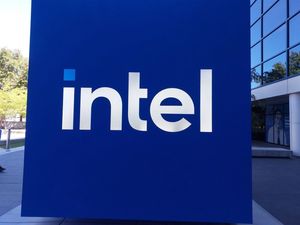
Water technology company Xylem (NYSE: XYL) reported Q3 CY2025 results topping the market’s revenue expectations, with sales up 7.8% year on year to $2.27 billion. The company’s full-year revenue guidance of $9 billion at the midpoint came in 0.5% above analysts’ estimates. Its non-GAAP profit of $1.37 per share was 11.1% above analysts’ consensus estimates.
Is now the time to buy Xylem? Find out by accessing our full research report, it’s free for active Edge members.
Xylem (XYL) Q3 CY2025 Highlights:
- Revenue: $2.27 billion vs analyst estimates of $2.23 billion (7.8% year-on-year growth, 1.9% beat)
- Adjusted EPS: $1.37 vs analyst estimates of $1.23 (11.1% beat)
- Adjusted EBITDA: $527 million vs analyst estimates of $491.2 million (23.2% margin, 7.3% beat)
- The company slightly lifted its revenue guidance for the full year to $9 billion at the midpoint from $8.95 billion
- Management raised its full-year Adjusted EPS guidance to $5.06 at the midpoint, a 5.9% increase
- Operating Margin: 14.7%, up from 13.3% in the same quarter last year
- Free Cash Flow Margin: 12.4%, up from 11.3% in the same quarter last year
- Organic Revenue rose 7% year on year vs analyst estimates of 5% growth (201.5 basis point beat)
- Market Capitalization: $36.37 billion
“The team delivered another strong quarter, exceeding expectations with disciplined execution on continuing commercial momentum,” said Matthew Pine, Xylem’s president and CEO.
Company Overview
Formed through a spinoff, Xylem (NYSE: XYL) manufactures and services engineered products across a wide variety of applications primarily in the water sector.
Revenue Growth
A company’s long-term performance is an indicator of its overall quality. Any business can experience short-term success, but top-performing ones enjoy sustained growth for years. Thankfully, Xylem’s 12.8% annualized revenue growth over the last five years was excellent. Its growth beat the average industrials company and shows its offerings resonate with customers, a helpful starting point for our analysis.
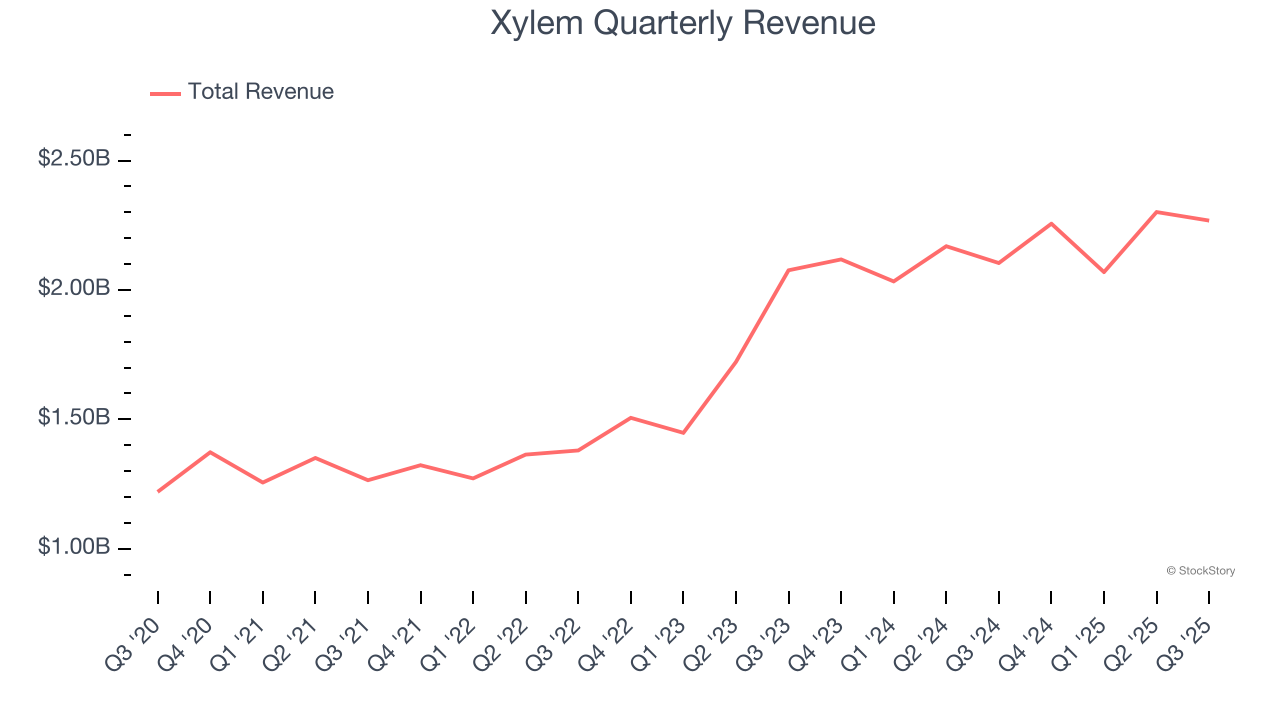
Long-term growth is the most important, but within industrials, a half-decade historical view may miss new industry trends or demand cycles. Xylem’s annualized revenue growth of 14.8% over the last two years is above its five-year trend, suggesting its demand was strong and recently accelerated. 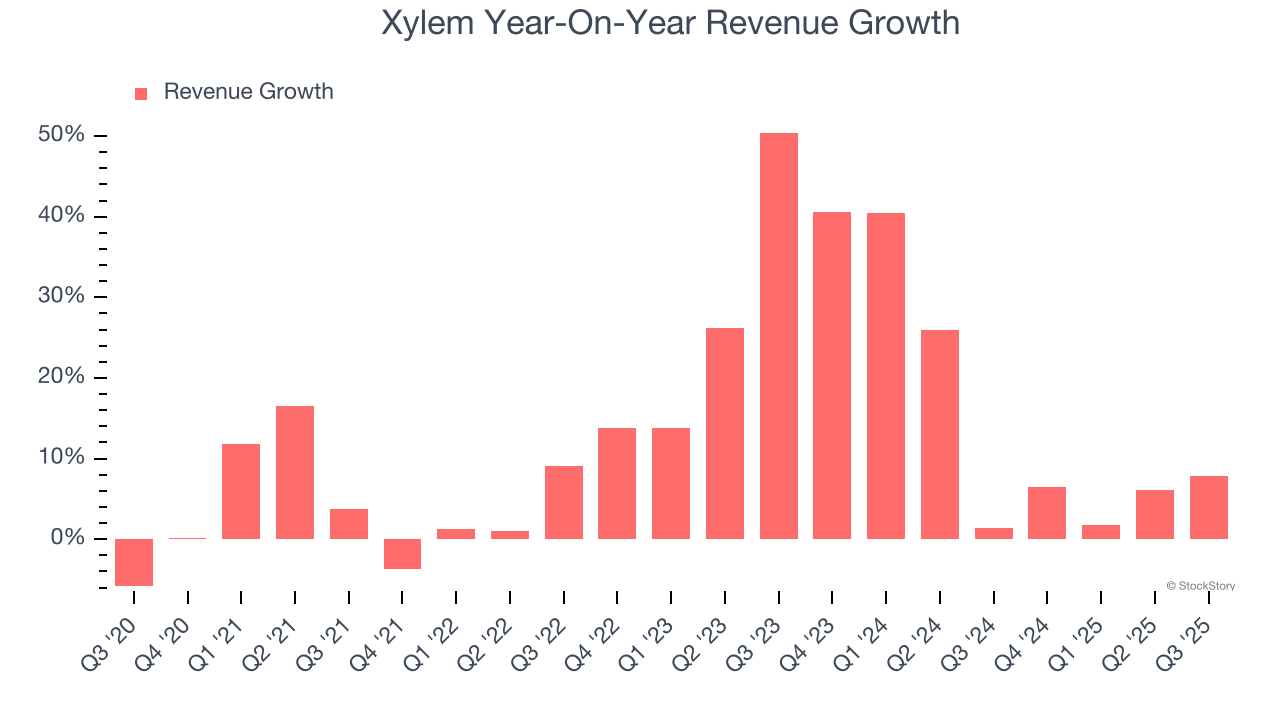
We can better understand the company’s sales dynamics by analyzing its organic revenue, which strips out one-time events like acquisitions and currency fluctuations that don’t accurately reflect its fundamentals. Over the last two years, Xylem’s organic revenue averaged 6.1% year-on-year growth. Because this number is lower than its two-year revenue growth, we can see that some mixture of acquisitions and foreign exchange rates boosted its headline results. 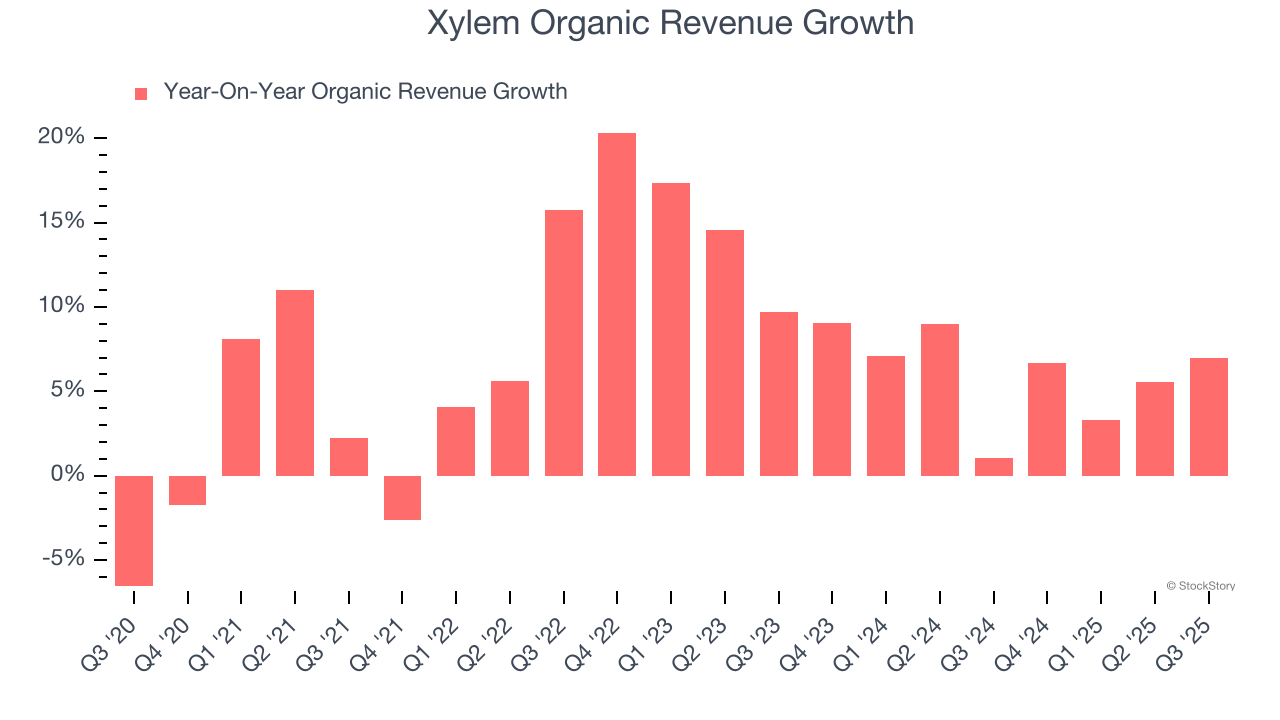
This quarter, Xylem reported year-on-year revenue growth of 7.8%, and its $2.27 billion of revenue exceeded Wall Street’s estimates by 1.9%.
Looking ahead, sell-side analysts expect revenue to grow 4.7% over the next 12 months, a deceleration versus the last two years. This projection doesn't excite us and indicates its products and services will face some demand challenges. At least the company is tracking well in other measures of financial health.
Here at StockStory, we certainly understand the potential of thematic investing. Diverse winners from Microsoft (MSFT) to Alphabet (GOOG), Coca-Cola (KO) to Monster Beverage (MNST) could all have been identified as promising growth stories with a megatrend driving the growth. So, in that spirit, we’ve identified a relatively under-the-radar profitable growth stock benefiting from the rise of AI, available to you FREE via this link.
Operating Margin
Xylem’s operating margin has risen over the last 12 months and averaged 11.3% over the last five years. Its solid profitability for an industrials business shows it manages its expenses efficiently and benefits from operating leverage as it scales. This is seen in its fast historical revenue growth and healthy gross margin, which is why we look at all three data points together.
Looking at the trend in its profitability, Xylem’s operating margin might fluctuated slightly but has generally stayed the same over the last five years. This raises questions about the company’s expense base because its revenue growth should have given it leverage on its fixed costs, resulting in better economies of scale and profitability.
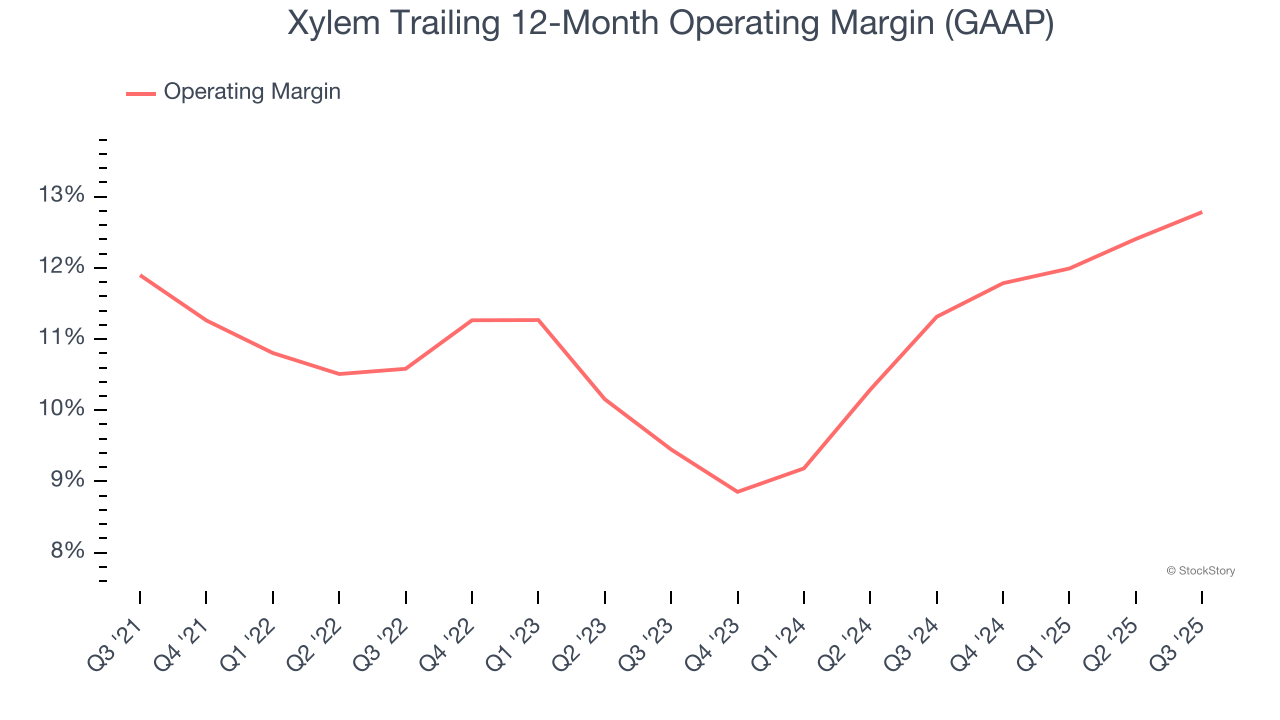
In Q3, Xylem generated an operating margin profit margin of 14.7%, up 1.4 percentage points year on year. Since its gross margin expanded more than its operating margin, we can infer that leverage on its cost of sales was the primary driver behind the recently higher efficiency.
Earnings Per Share
Revenue trends explain a company’s historical growth, but the long-term change in earnings per share (EPS) points to the profitability of that growth – for example, a company could inflate its sales through excessive spending on advertising and promotions.
Xylem’s EPS grew at an astounding 17.7% compounded annual growth rate over the last five years, higher than its 12.8% annualized revenue growth. This tells us the company became more profitable on a per-share basis as it expanded.
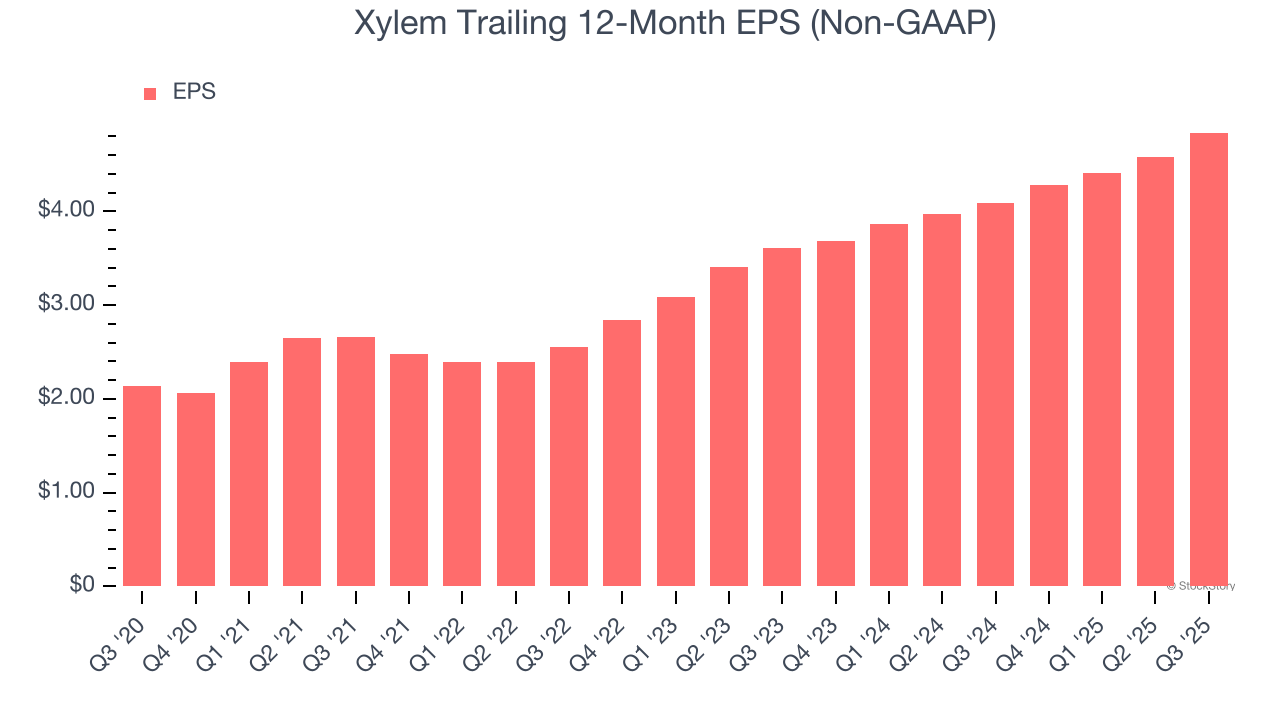
Like with revenue, we analyze EPS over a more recent period because it can provide insight into an emerging theme or development for the business.
For Xylem, its two-year annual EPS growth of 15.8% was lower than its five-year trend. We still think its growth was good and hope it can accelerate in the future.
In Q3, Xylem reported adjusted EPS of $1.37, up from $1.11 in the same quarter last year. This print easily cleared analysts’ estimates, and shareholders should be content with the results. Over the next 12 months, Wall Street expects Xylem’s full-year EPS of $4.84 to grow 8.2%.
Key Takeaways from Xylem’s Q3 Results
We were impressed by Xylem’s optimistic full-year EPS guidance, which blew past analysts’ expectations. We were also glad its EBITDA outperformed Wall Street’s estimates. Zooming out, we think this was a solid print. The stock traded up 2.8% to $153.54 immediately after reporting.
Sure, Xylem had a solid quarter, but if we look at the bigger picture, is this stock a buy? What happened in the latest quarter matters, but not as much as longer-term business quality and valuation, when deciding whether to invest in this stock. We cover that in our actionable full research report which you can read here, it’s free for active Edge members.


